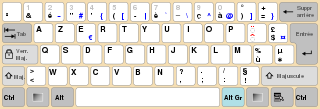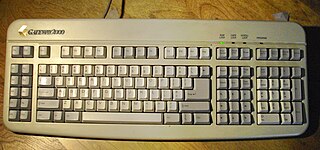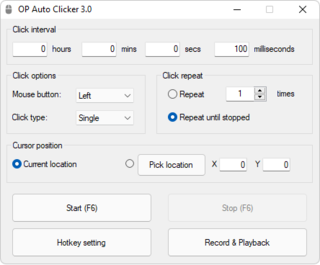
In computer programming, a macro is a rule or pattern that specifies how a certain input should be mapped to a replacement output. Applying a macro to an input is known as macro expansion. The input and output may be a sequence of lexical tokens or characters, or a syntax tree. Character macros are supported in software applications to make it easy to invoke common command sequences. Token and tree macros are supported in some programming languages to enable code reuse or to extend the language, sometimes for domain-specific languages.

QWERTY is a keyboard layout for Latin-script alphabets. The name comes from the order of the first six keys on the top left letter row of the keyboard. The QWERTY design is based on a layout created for the Sholes and Glidden typewriter and sold to E. Remington and Sons in 1873. It became popular with the success of the Remington No. 2 of 1878, and remains in ubiquitous use.
In computing, a modifier key is a special key on a computer keyboard that temporarily modifies the normal action of another key when pressed together. By themselves, modifier keys usually do nothing; that is, pressing any of the ⇧ Shift, Alt, or Ctrl keys alone does not (generally) trigger any action from the computer.

In computing, a Control keyCtrl is a modifier key which, when pressed in conjunction with another key, performs a special operation. Similarly to the Shift key, the Control key rarely performs any function when pressed by itself. The Control key is located on or near the bottom left side of most keyboards, with many featuring an additional one at the bottom right.

AZERTY is a specific layout for the characters of the Latin alphabet on typewriter keys and computer keyboards. The layout takes its name from the first six letters to appear on the first row of alphabetical keys; that is,. Similar to the QWERTZ layout, it is modelled on the English QWERTY layout. It is used in France and Belgium, although each of these countries has its own national variation on the layout. Luxembourg and Switzerland use the Swiss QWERTZ keyboard. Most of the residents of Quebec, the mainly French-speaking province of Canada, use a QWERTY keyboard that has been adapted to the French language such as the Multilingual Standard keyboard CAN/CSA Z243.200-92 which is stipulated by the government of Quebec and the Government of Canada.

A function key is a key on a computer or terminal keyboard that can be programmed so as to cause an operating system command interpreter or application program to perform certain actions, a form of soft key. On some keyboards/computers, function keys may have default actions, accessible on power-on.
A scancode is the data that most computer keyboards send to a computer to report which keys have been pressed. A number, or sequence of numbers, is assigned to each key on the keyboard.

A compose key is a key on a computer keyboard that indicates that the following keystrokes trigger the insertion of an alternate character, typically a precomposed character or a symbol.

Arrow keys or cursor movement keys are keys on a computer keyboard that are either programmed or designated to move the cursor in a specified direction.
The Nostromo is a USB video game controller designed by Belkin. Formerly called the Belkin Nostromo SpeedPad, it was succeeded by the Razer Nostromo, which was co-developed by Belkin and Razer. It can be considered a keyboard/joystick/mouse hybrid. It can also be used outside of games, for example to support cartographic software.

Japanese input methods are used to input Japanese characters on a computer.

The PS/2 port is a 6-pin mini-DIN connector used for connecting keyboards and mice to a PC compatible computer system. Its name comes from the IBM Personal System/2 series of personal computers, with which it was introduced in 1987. The PS/2 mouse connector generally replaced the older DE-9 RS-232 "serial mouse" connector, while the PS/2 keyboard connector replaced the larger 5-pin/180° DIN connector used in the IBM PC/AT design. The PS/2 keyboard port is electrically and logically identical to the IBM AT keyboard port, differing only in the type of electrical connector used. The PS/2 platform introduced a second port with the same design as the keyboard port for use to connect a mouse; thus the PS/2-style keyboard and mouse interfaces are electrically similar and employ the same communication protocol. However, unlike the otherwise similar Apple Desktop Bus connector used by Apple, a given system's keyboard and mouse port may not be interchangeable since the two devices use different sets of commands and the device drivers generally are hard-coded to communicate with each device at the address of the port that is conventionally assigned to that device.

The Gateway AnyKey is a programmable PC keyboard that was sold with desktop computers from the Gateway 2000 company roughly from 1990 to 1997. It was manufactured in at least five known versions and incarnations by Tucson, Arizona-based Maxi Switch, now a subsidiary of LiteOn Technology Corporation. The AnyKey is no longer manufactured, with the latest dated model available marked 1997. Maxi Switch, Gateway, and LiteOn currently do not offer any product labeled as or comparable to the AnyKey.

A Hebrew keyboard comes in two different keyboard layouts. Most Hebrew keyboards are bilingual, with Latin characters, usually in a US Qwerty layout. Trilingual keyboard options also exist, with the third script being Arabic or Russian, due to the sizable Arabic- and Russian-speaking populations in Israel.

An auto clicker is a type of software or macro that can be used to automate the clicking of a mouse on a computer screen element. Some clickers can be triggered to repeat recorded input.

Unicode input is the insertion of a specific Unicode character on a computer by a user; it is a common way to input characters not directly supported by a physical keyboard. Unicode characters can be produced either by selecting them from a display or by typing a certain sequence of keys on a physical keyboard. In addition, a character produced by one of these methods in one web page or document can be copied into another. In contrast to ASCII's 96 element character set, Unicode encodes hundreds of thousands of graphemes (characters) from almost all of the world's written languages and many other signs and symbols besides.

A computer keyboard is a peripheral input device modeled after the typewriter keyboard which uses an arrangement of buttons or keys to act as mechanical levers or electronic switches. Replacing early punched cards and paper tape technology, interaction via teleprinter-style keyboards have been the main input method for computers since the 1970s, supplemented by the computer mouse since the 1980s.
Emacs, originally named EMACS, is a family of text editors that are characterized by their extensibility. The manual for the most widely used variant, GNU Emacs, describes it as "the extensible, customizable, self-documenting, real-time display editor". Development of the first Emacs began in the mid-1970s, and work on its direct descendant, GNU Emacs, is ongoing; its latest version is 29.1, released July 2023.

Dvorak is a keyboard layout for English patented in 1936 by August Dvorak and his brother-in-law, William Dealey, as a faster and more ergonomic alternative to the QWERTY layout. Dvorak proponents claim that it requires less finger motion and as a result reduces errors, increases typing speed, reduces repetitive strain injuries, or is simply more comfortable than QWERTY.

A keyboard layout is any specific physical, visual or functional arrangement of the keys, legends, or key-meaning associations (respectively) of a computer keyboard, mobile phone, or other computer-controlled typographic keyboard.















